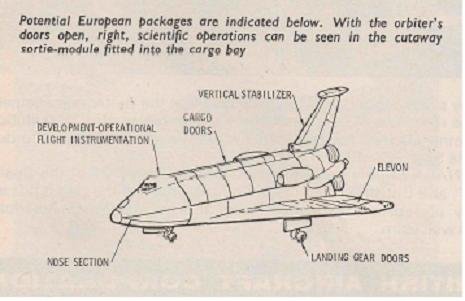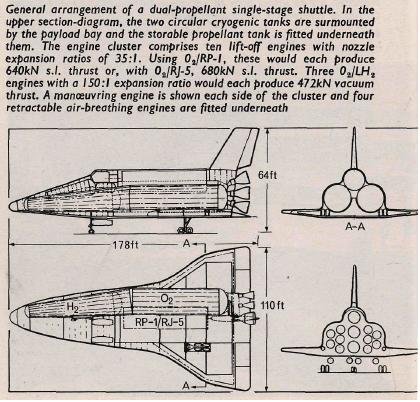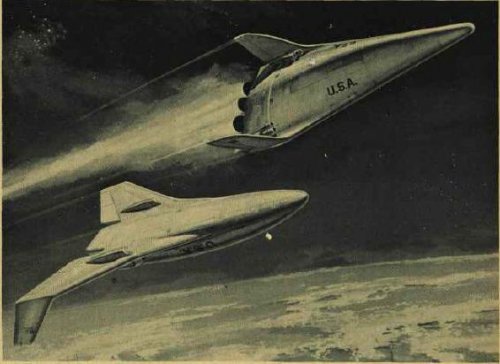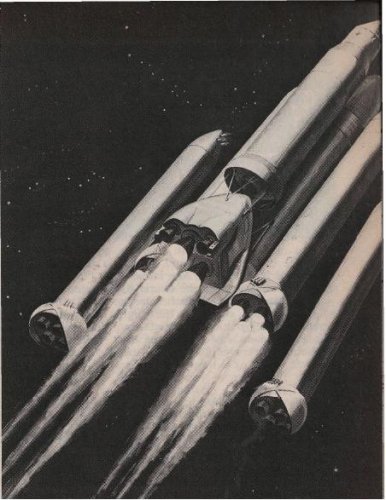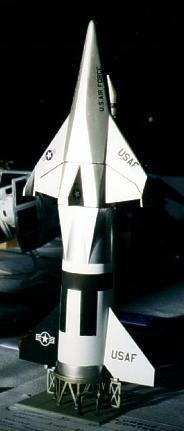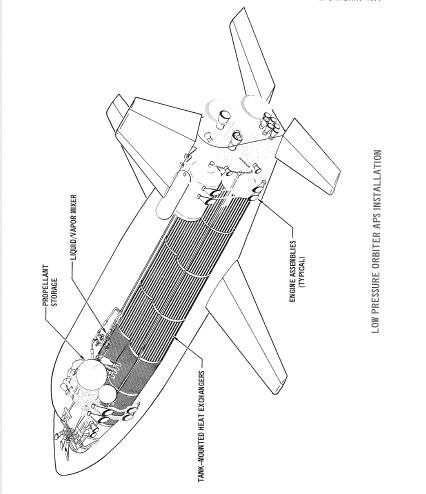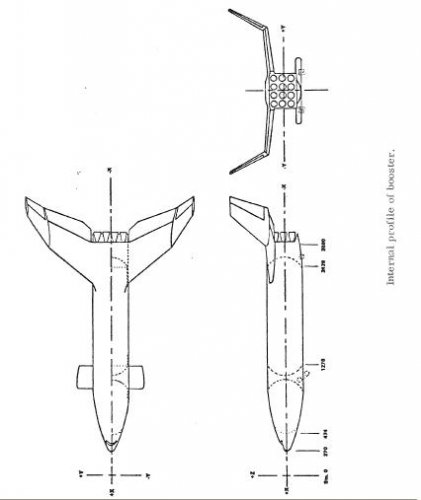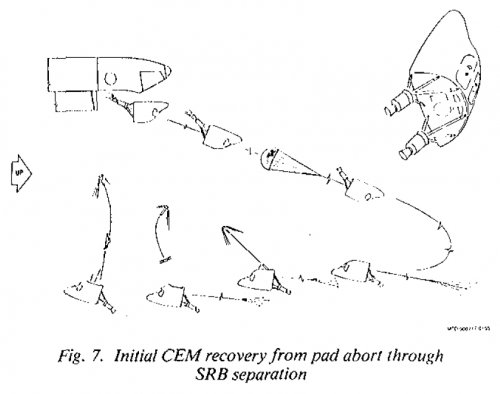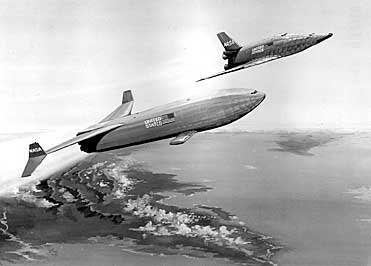You are using an out of date browser. It may not display this or other websites correctly.
You should upgrade or use an alternative browser.
You should upgrade or use an alternative browser.
Various US Reusable Launch Vehicles (RLV) Projects
- Thread starter PMN1
- Start date
Archibald said:To complete this website, here's another which narrate full story of early shuttle years (1969-1973). http://www.abo.fi/~mlindroo/SpaceLVs/Slides/index.htm

Interesting, I hadn't realised there was a NASA equivalent of Truax's Sea Dragon (even though i've seen that site a few times) admitedley with multiple engines as opposed to the single big engine of Sea Dragon.
NASA
http://www.abo.fi/~mlindroo/SpaceLVs/Slides/sld042.htm
Truax
http://www.astronautix.com/lvs/searagon.htm
- Joined
- 1 April 2006
- Messages
- 10,729
- Reaction score
- 6,754
From AIAA paper 78-1469
Space Shuttle Orbiter Configuration Case History
H. A. Scott (one of Shuttle Orbiter backbone men)
Rockwell International
Los Angeles, California
AlAA AIRCRAFT SYSTEMS AND TECHNOLOGY CONFERENCE
Los Angeles, Calif./August 21-23,1978
Favourite Orionblamblam's C-0157 shuttle also presents)))
Space Shuttle Orbiter Configuration Case History
H. A. Scott (one of Shuttle Orbiter backbone men)
Rockwell International
Los Angeles, California
AlAA AIRCRAFT SYSTEMS AND TECHNOLOGY CONFERENCE
Los Angeles, Calif./August 21-23,1978
Favourite Orionblamblam's C-0157 shuttle also presents)))
Attachments
- Joined
- 26 May 2006
- Messages
- 32,689
- Reaction score
- 11,918
Hi,
here is the early methods to launch the NASA Orbiter shuttle at the first
page and a drawing to it with two site jet engines.
http://www.flightglobal.com/PDFArchive/View/1972/1972%20-%201458.html
http://www.flightglobal.com/PDFArchive/View/1972/1972%20-%201460.html
here is the early methods to launch the NASA Orbiter shuttle at the first
page and a drawing to it with two site jet engines.
http://www.flightglobal.com/PDFArchive/View/1972/1972%20-%201458.html
http://www.flightglobal.com/PDFArchive/View/1972/1972%20-%201460.html
Attachments
That's not "early," that's "late." Very near the end of the studies on just how to put the Shuttle into orbit.
- Joined
- 13 August 2007
- Messages
- 7,149
- Reaction score
- 6,522
very late, beyond Phase B study
the Shuttle had planned 2 jet engines for landing (and Shuttle transport)
and a crew escape system (cockpit separates by pirotech, solid rocket, Parasute)
but money cuts and weight problem
went Jet engine first out and crew escape system as last...
the Shuttle had planned 2 jet engines for landing (and Shuttle transport)
and a crew escape system (cockpit separates by pirotech, solid rocket, Parasute)
but money cuts and weight problem
went Jet engine first out and crew escape system as last...
Just call me Ray
ACCESS: Top Secret
- Joined
- 26 August 2007
- Messages
- 672
- Reaction score
- 42
A model of the C-1057 study is available:
http://www.fantastic-plastic.com/RockwellC-1057BreadboxShuttlePage.htm
http://www.fantastic-plastic.com/RockwellC-1057BreadboxShuttlePage.htm
- Joined
- 26 May 2006
- Messages
- 32,689
- Reaction score
- 11,918
- Joined
- 26 May 2006
- Messages
- 32,689
- Reaction score
- 11,918
Hi,
the space shuttle derivative to can carry 90,100 and 230 to 270 tonnes.
http://www.flightglobal.com/pdfarchive/view/1979/1979%20-%200871.html
http://www.flightglobal.com/pdfarchive/view/1979/1979%20-%200872.html
the space shuttle derivative to can carry 90,100 and 230 to 270 tonnes.
http://www.flightglobal.com/pdfarchive/view/1979/1979%20-%200871.html
http://www.flightglobal.com/pdfarchive/view/1979/1979%20-%200872.html
Attachments
What kind of engines are specified for the liquid-fueled boosters on the shuttle-derived vehicle?
Mark Wade's site has a drawing of the shuttle with similar LRB's (four engines per booster and shutters to protect the engines during splashdown.) But his drawing is from a later study that utilizes STME's.
Also looks like the SSME's are in a recoverable pod, brought back to earth with a pair of retro rockets (presumably solid rockets, but Shuttle OMS engines aren't out of the question.)
Mark Wade's site has a drawing of the shuttle with similar LRB's (four engines per booster and shutters to protect the engines during splashdown.) But his drawing is from a later study that utilizes STME's.
Also looks like the SSME's are in a recoverable pod, brought back to earth with a pair of retro rockets (presumably solid rockets, but Shuttle OMS engines aren't out of the question.)
- Joined
- 26 May 2006
- Messages
- 32,689
- Reaction score
- 11,918
Hi,
the shuttle contenders from McDonnell Douglas/Martin Marietta,North American
Rockwell/General Dynamics and Grumman/Boeing.
Also the Convair shuttle of early 1960s.
http://www.flightglobal.com/pdfarchive/view/1972/1972%20-%200229.html?search=spacecraft%201972
http://www.astronautix.com/craft/concraft.htm
the shuttle contenders from McDonnell Douglas/Martin Marietta,North American
Rockwell/General Dynamics and Grumman/Boeing.
Also the Convair shuttle of early 1960s.
http://www.flightglobal.com/pdfarchive/view/1972/1972%20-%200229.html?search=spacecraft%201972
http://www.astronautix.com/craft/concraft.htm
Attachments
- Joined
- 29 September 2006
- Messages
- 1,628
- Reaction score
- 1,028
I remember reading in an Old AWST (1970?) about a Rockwell proposal for the Phase B (TSTO) Shuttle which involved BAC work on the booster stage.
Does anyone have more info on this, or was it one of those 'briefly floated' ideas that sink beneath history's waves - never to be seen again?
Starviking
Does anyone have more info on this, or was it one of those 'briefly floated' ideas that sink beneath history's waves - never to be seen again?
Starviking
- Joined
- 29 September 2006
- Messages
- 1,628
- Reaction score
- 1,028
The Final McDD and NAR Shuttle Proposals from
http://www.flightglobal.com/PDFArchive/View/1972/1972%20-%201737.html
Note, that according to the link the NAR Shuttle has abort boosters attached to the shuttle wings - and a thrust termination device at the nose of each SRB. :'(
Starviking
http://www.flightglobal.com/PDFArchive/View/1972/1972%20-%201737.html
Note, that according to the link the NAR Shuttle has abort boosters attached to the shuttle wings - and a thrust termination device at the nose of each SRB. :'(
Starviking
Attachments
- Joined
- 26 May 2006
- Messages
- 32,689
- Reaction score
- 11,918
archipeppe
ACCESS: Top Secret
- Joined
- 18 October 2007
- Messages
- 2,291
- Reaction score
- 2,339
hesham said:Hi,
a flight impression of NASA space shuttle.
http://www.flightglobal.com/pdfarchive/view/1968/1968%20-%201653.htm
This image depict, obviously, some FDL concept (as a sort of "deformed FDL-5") clearly recognizable are the vertical launch assembly, the two jettisonable tanks (as X 15ish style) and the folded wings extracted just prior landing.
Anyway this is the first image, I've ever seen, that is depicting an FDL mission.
Many thanks Hesham for this interesting contribution about the matter...
- Joined
- 26 May 2006
- Messages
- 32,689
- Reaction score
- 11,918
hesham said:Hi,
I think anther drawing to Grumman two-vehicles (booster and orbiter) concept.
Not Grumman. Maxime Faget's "DC-3" concept.
XP67_Moonbat
ACCESS: Top Secret
- Joined
- 16 January 2008
- Messages
- 2,246
- Reaction score
- 377
Hesh,
Good guess, buddy. But it's already been covered in over Postwar. Check it out:
http://www.secretprojects.co.uk/forum/index.php/topic,5446.0/highlight,hsra.html
Good guess, buddy. But it's already been covered in over Postwar. Check it out:
http://www.secretprojects.co.uk/forum/index.php/topic,5446.0/highlight,hsra.html
lantinian
ACCESS: Top Secret
- Joined
- 24 March 2007
- Messages
- 538
- Reaction score
- 127
An to all those interested to heard from the very people that designed,build and operated the Space Shuttle, here is the link to the complete lectures as part of the MIT OpencourseWare.
These are 20+ lectures, each 1:30+ long. It was quite remarkable to hear them.
http://ocw.mit.edu/OcwWeb/Aeronautics-and-Astronautics/16-885JFall-2005/CourseHome/index.htm?r=iTunes
These are 20+ lectures, each 1:30+ long. It was quite remarkable to hear them.
Hello!
I knew that Shuttle used a solid-fuel upper stage, the IUS. At the other end of the performance spectrum, used of the Centaur was stopped only by the Challenger disaster
(frightening story here http://space.co.uk/Features/Newsletters/200811November/FlightsoftheDeathStarPage1/tabid/628/Default.aspx)
But the Agena is new to me
http://ntrs.nasa.gov/search.jsp?N=0&Ntk=all&Ntx=mode%20matchall&Ntt=shuttle%2Fagena
After storable propellants would nicely fit the performance gap between solid and cryogenic fuel...
Agena in a shuttle bay = as dangerous as a Centaur ?
(non cryogenic, but highly toxic corrosive... on the other hand Shuttle OMS use storable propellants)
I knew that Shuttle used a solid-fuel upper stage, the IUS. At the other end of the performance spectrum, used of the Centaur was stopped only by the Challenger disaster
(frightening story here http://space.co.uk/Features/Newsletters/200811November/FlightsoftheDeathStarPage1/tabid/628/Default.aspx)
But the Agena is new to me
http://ntrs.nasa.gov/search.jsp?N=0&Ntk=all&Ntx=mode%20matchall&Ntt=shuttle%2Fagena
After storable propellants would nicely fit the performance gap between solid and cryogenic fuel...
Agena in a shuttle bay = as dangerous as a Centaur ?
(non cryogenic, but highly toxic corrosive... on the other hand Shuttle OMS use storable propellants)
- Joined
- 13 August 2007
- Messages
- 7,149
- Reaction score
- 6,522
Agena in a shuttle bay = as dangerous as a Centaur ?
(non cryogenic, but highly toxic corrosive... on the other hand Shuttle OMS use storable propellants)
the OMS used fuel is monomethylhydrazine (MMH), which is oxidized with nitrogen tetroxide (N2O4).
http://en.wikipedia.org/wiki/Monomethylhydrazine
http://en.wikipedia.org/wiki/Dinitrogen_tetroxide
safe storable propellants
the Agena used fuel is UDMH , which is oxidized with Inhibited white fuming nitric acid
http://en.wikipedia.org/wiki/UDMH
http://en.wikipedia.org/wiki/White_fuming_nitric_acid
the oxidizer tank need protective metallic fluoride coating !
something you don't want in a Shuttle cargobay in case the oxidizer tank, feedline or valve leaksBeing a powerful oxidizing agent, nitric acid reacts violently with many organic materials and the reactions may be explosive
Wat i wonder is, had Martin never proposed Transtage for Shuttle upperstage ?
(they had proposed Transtage as ad-on booster under the ET in 1982)
- Joined
- 26 September 2008
- Messages
- 1,925
- Reaction score
- 640
Michel Van said:Wat i wonder is, had Martin never proposed Transtage for Shuttle upperstage ?
(they had proposed Transtage as ad-on booster under the ET in 1982)
I think they did. There's a congressional hearing report from around 1972 or so that includes presentations from about four different companies proposing "space tugs" for the shuttle. There were several Agena proposals, a Grumman proposal, and I think a Martin proposal using the Transtage. I'll look around for it in my files. From vague memory, I think that the Transtage had some early performance problems, but these were later solved. However, I believe I also heard from some people familiar with it that it was not very popular. The Air Force people who had to work with it did not like it.
I remember that there were at least three Agena proposals--a "large tank" Agena (their preferred design), an Agena with drop tanks, and three separate Agenas with separate payloads.
- Joined
- 1 April 2006
- Messages
- 10,729
- Reaction score
- 6,754
- Joined
- 29 September 2006
- Messages
- 1,628
- Reaction score
- 1,028
flateric said:1990s Rockwell thoughts of Space Shuttle evolution
That first picture with a reference length of 1486 inches - so were they thinking of adding 20 inches to the orbiter? I've a reference to Endeavor being 1466 inches long - but perhaps the measurements aren't directly comparable...
1466 inches is the length of a standard orbiter, but it's probably measured from nose to tail along the longitudinal axis. The 1486 inch figure likely references a measurement from the nose to end of the fuselage boat-tail area. It looks like they're adding an extra segment to the payload bay, and that should be much longer than 20 inches.
I really question if the "advanced orbiter" proposal was serious. Seeing as how the shuttle was designed to carry payloads bigger than the "national assets" on the drawing boards during the early 70's, it would seem to have sufficient payload volume.
At the same time, I recall reading John Young's ideas for an "advanced orbiter." He wanted features like thrust termination on the SRB's and canards on the orbiter for better control on approach & landing. The former idea is idiotic, as thrust termination (blowing the nose caps) would likely rupture the ET and kill the crew. Canards aren't such a bad idea, but it's not easy to see how you could stow them for re-entry without adding a lot of mass.
I really question if the "advanced orbiter" proposal was serious. Seeing as how the shuttle was designed to carry payloads bigger than the "national assets" on the drawing boards during the early 70's, it would seem to have sufficient payload volume.
At the same time, I recall reading John Young's ideas for an "advanced orbiter." He wanted features like thrust termination on the SRB's and canards on the orbiter for better control on approach & landing. The former idea is idiotic, as thrust termination (blowing the nose caps) would likely rupture the ET and kill the crew. Canards aren't such a bad idea, but it's not easy to see how you could stow them for re-entry without adding a lot of mass.
- Joined
- 13 August 2007
- Messages
- 7,149
- Reaction score
- 6,522
CFE said:At the same time, I recall reading John Young's ideas for an "advanced orbiter." He wanted features like thrust termination on the SRB's and canards on the orbiter for better control on approach & landing. The former idea is idiotic, as thrust termination (blowing the nose caps) would likely rupture the ET and kill the crew. Canards aren't such a bad idea, but it's not easy to see how you could stow them for re-entry without adding a lot of mass.
there were other crazy "Ideas" would likely rupture the ET:
like put SRB segments or a Titan-II stage under the ET as "add-on Booster"
LBM 4 Titan-II tanks with total 159t fuel and 2xAerojet LR87-AJ-11 engine with total 200 ton trust
total weight 180t LBM ignition 5 sec after Shuttle liftoff
+5 tons payload for USAF mission (from Vandenberg AFB?)
another was to build Additional fueltanks inside payloadbay for the Orbital Maneuvering System
source: German space book
"Die Grenzenlose Dimension der Raumfahrt: Band 1"
by Harry o. Ruppe, publish 1980 ISBN 3430178847
page 647 - 640
- Joined
- 13 August 2007
- Messages
- 7,149
- Reaction score
- 6,522
CFE said:What kind of engines are specified for the liquid-fueled boosters on the shuttle-derived vehicle?
Mark Wade's site has a drawing of the shuttle with similar LRB's (four engines per booster and shutters to protect the engines during splashdown.) But his drawing is from a later study that utilizes STME's.
in most LRB study have 4xSSME for 2 reasion
1- the SSME was the only High trust engine NASA hab in Time
2- the Shuttle launch profil need Variable Thrust, otherwise it will ripp the wings off
Again the SSME was only engine that can do this.
Flight global also has something (around 1980 or so) about adding small strapons to the usual SRBs.
This was intented to achieve USAF requirement to Polar orbit (shuttle payload was aparently too weak for them)
http://www.flightglobal.com/pdfarchive/view/1978/1978%20-%202302.html?search=SRBs
This was intented to achieve USAF requirement to Polar orbit (shuttle payload was aparently too weak for them)
http://www.flightglobal.com/pdfarchive/view/1978/1978%20-%202302.html?search=SRBs
XP67_Moonbat
ACCESS: Top Secret
- Joined
- 16 January 2008
- Messages
- 2,246
- Reaction score
- 377
OK,
Ares I & V are in the public eye a lot lately. And now we have the DIRECT guys making their pitch to Obama. Here's the PM article and a link to their homepage:
http://www.origin.popularmechanics.com/science/air_space/4298615.html
http://www.directlauncher.com/
I do get a kick on how the media seems to impart concepts like Ares and DIRECT the feel of being new or somehow groundbreaking. But the concept of Shuttle-derived boosters are actually old hat. I have hazy, old memories from the very back of my mind about this. These memories come from around the time right after Challenger. I was about 9 or 10 at the time.
I vaguely recall reading something when I was a kid about a booster derived from a single SRB. I also hazily recall a picture of two SRB's stacked on the pad without an ET or Orbiter. I don't recall how that was related to the SRB concept, if it was. And I don't remember what magazine or book this was in.
So I did a Google search and I found references to a concept called SRB-X. From Global Security- http://www.globalsecurity.org/space/systems/srb-x.htm
Then there's this. If you scroll down to the bottom of page 3, you'll see it:
https://mira.hq.nasa.gov/history/ws/hdmshrc/all/main/Blob/41010.pdf;jsessionid=2832AA0615A0BDF37CDE11DA5BAE543C?m=12&order=SERIES
Also found this: http://www.flightglobal.com/articles/2007/07/06/215384/spaceflight-picture-of-the-week-6-july-2007.html
But none of the images I've found match what I recall. I'm sure what I saw was a single booster.
So if anybody else remembers something about this, I'd love to hear about it.
Moonbat
PS- I'm still not sure what the stacked pair of SRB's has to with all this. Maybe that was some kind of fit-test. But the memory of that, along with SRB-X, come from around the same time.
Ares I & V are in the public eye a lot lately. And now we have the DIRECT guys making their pitch to Obama. Here's the PM article and a link to their homepage:
http://www.origin.popularmechanics.com/science/air_space/4298615.html
http://www.directlauncher.com/
I do get a kick on how the media seems to impart concepts like Ares and DIRECT the feel of being new or somehow groundbreaking. But the concept of Shuttle-derived boosters are actually old hat. I have hazy, old memories from the very back of my mind about this. These memories come from around the time right after Challenger. I was about 9 or 10 at the time.
I vaguely recall reading something when I was a kid about a booster derived from a single SRB. I also hazily recall a picture of two SRB's stacked on the pad without an ET or Orbiter. I don't recall how that was related to the SRB concept, if it was. And I don't remember what magazine or book this was in.
So I did a Google search and I found references to a concept called SRB-X. From Global Security- http://www.globalsecurity.org/space/systems/srb-x.htm
Then there's this. If you scroll down to the bottom of page 3, you'll see it:
https://mira.hq.nasa.gov/history/ws/hdmshrc/all/main/Blob/41010.pdf;jsessionid=2832AA0615A0BDF37CDE11DA5BAE543C?m=12&order=SERIES
Also found this: http://www.flightglobal.com/articles/2007/07/06/215384/spaceflight-picture-of-the-week-6-july-2007.html
But none of the images I've found match what I recall. I'm sure what I saw was a single booster.
So if anybody else remembers something about this, I'd love to hear about it.
Moonbat
PS- I'm still not sure what the stacked pair of SRB's has to with all this. Maybe that was some kind of fit-test. But the memory of that, along with SRB-X, come from around the same time.
Attachments
XP67_Moonbat
ACCESS: Top Secret
- Joined
- 16 January 2008
- Messages
- 2,246
- Reaction score
- 377
Here's a little something on Shuttle-derived concepts I found on my quest for SRB-X.
http://chapters.nss.org/ny/nyc/Shuttle-Derived%20Vehicles%20Modified.pdf
Nice read.
Moonbat
http://chapters.nss.org/ny/nyc/Shuttle-Derived%20Vehicles%20Modified.pdf
Nice read.
Moonbat
Similar threads
-
-
-
-
Lockheed-California Earth-to-space shuttle of 1964
- Started by hesham
- Replies: 18
-
Candidate Space Shuttle Orbiters Wind Tunnel Studies 1969 NASA Langley Research
- Started by sferrin
- Replies: 2







